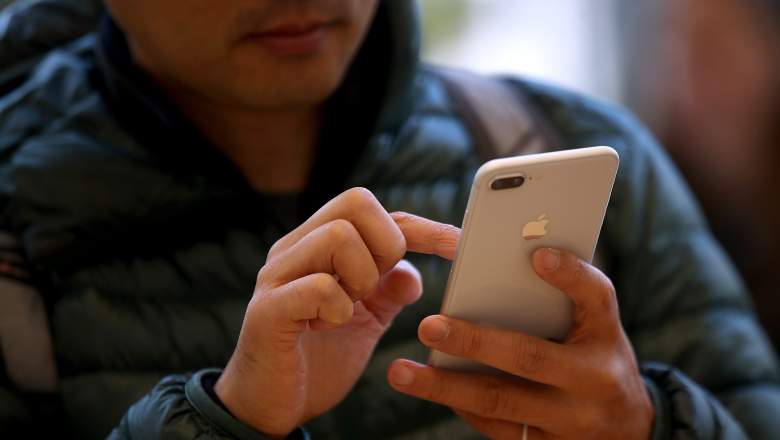
Getty A customer inspects an iPhone.
Today is the very first time that a Presidential Alert test has been sent out nationwide. And as soon as the alert was sent, people began wondering if there was a way to block the Presidential Alert, disable it, or turn it off.
Unfortunately, you cannot easily opt out of the Presidential Alert, but there are a few workarounds that might work, although they’re difficult to implement. If you get a phone that is not WEA compatible or if your wireless provider doesn’t participate in the WEA system, you can avoid getting Presidential Alerts. And people are testing other ways to block the alert, but it’s not yet verified if those methods will work.
The Presidential Alert is mandatory, so you can’t voluntarily turn it off or opt out. Legally, wireless companies that are voluntarily participating in the WEA system are required by law to make presidential alerts unblockable to phones and other mobile devices that use cell data, like iPads. However, there are some ways to avoid receiving one, if you want to go out of your way to do so.
Use a Provider That Isn’t Participating in the WEA System
A wireless provider must be participating in the WEA in order to receive the test message. So if you want to avoid getting any Wireless Emergency Alerts, including the Presidential Alerts, the easiest method is getting a phone from a carrier that hasn’t voluntarily signed up to be part of the WEA system. But these aren’t as easy to find as you might think. Most carriers are participating in the WEA system, including major carriers like Cricket, Verizon, AT&T, T-Mobile, and Sprint. GCI Wireless in Alaska also participates.
Get a Phone That Isn’t WEA Compatible
Only phones that are WEA compatible, turned on, and within range of an active cell tower will actually get the message. So if you don’t want to get the Presidential alerts, use a phone that isn’t WEA compatible. But you’ll likely need to get an older phone for that, since most newer phones are made to be compatible. If your phone is WEA compatible, it should have a logo on the packaging and instruction manual that reads: “Wirelesss Emergency Alerts Capable.”
On a list provided by AT&T, the only phone they offer that is not WEA compatible is the Samsung Gear S. The Cisco AT&T Microcell is also not WEA capable.
According to Verizon, all iPhones are WEA capable as long as they are using iOS 6 or later.
According to Cricket, their devices that are WEA capable are phones from Alcatel, Coolpad, Motorola, Samsung, and ZTE. You can see the full list here.
Some People Are Testing Methods of Turning Off the Alerts on Rooted or Jailbroken Phones, But These Are Untested
A number of people are testing ways to turn off the presidential alerts through jailbroken or rooted phones, but these methods may bring risks of causing other problems with your phone. And since this is the first Presidential Alert to be sent, it’s unclear if any of these methods actually work.
A thread from 2012 on XDA Developers discusses in detail how to disable presidential alerts on a rooted Android phone. It has comments dating all the way to present day, so if you’re really wanting to try to disable presidential alerts, this might be your best source. Redditor CelticWhisper tried the same series of steps on a rooted Android and discussed them here. They involved putting the phone in airplane mode, rooting the phone, unlocking bootloader, installing Titanium Backup and upgrading to Pro, freezing “cell broadcasts” in Titanium Backup, using the SU terminal to navigate to CellBroadcastReceiver.apk and deleting it, rebooting the phone, and verifying the .apk is gone. As noted earlier, these steps might work but they aren’t yet verified and might cause other phone issues.
One person on Reddit said that because the background alert service was draining their battery, they simply used root access to freeze the emergency alerts package (but “I do not recommend this,” they added.) Others mentioned that disabling or freezing the emergency alerts would survive updates and could be reversible any time without deleting CellBroadcastReceiver on a rooted phone. All these methods aren’t yet verified.
You should note that even though some phones appear to have settings where you can turn off emergency alerts, this actually won’t turn off presidential alerts, which are mandatory for any participating provider.
In general, it’s probably not a good idea to turn off emergency alert broadcasts. These aren’t supposed to be used for political purposes, and you likely would want to know if a nationwide emergency was occurring.
Turn Off Your Phone If You Know a Presidential Alert Test Is Coming
If you know a test is coming, you can simply turn off your phone to avoid receiving the presidential alert. You might also be able to put it in airplane mode to avoid the alert, but this hasn’t been confirmed to work yet.
Jeh Johnson, Homeland Security chief, told CBS This Morning that the presidential alert “should be reserved for true situations, true emergencies when we need to get the public’s attention.” It’s not supposed to be used for political purposes, and it will only be used very rarely. The political purposes point is especially important, he noted, since people cannot opt out of the presidential alert. There are laws in place and protocols that make sure the use is in accordance with the law, he emphasized.
The WEA only sends out three types of alerts: imminent threats in a specific region (such as extreme weather), AMBER alerts, and Presidential alerts about national emergencies. And although you can opt out of AMBER alerts and weather alerts, you can’t opt out of Presidential alerts. Interestingly, the WARN Act of 2006 establishes that the public should be able to opt out of any WEA alert except the Presidential alert, FEMA noted.
Comments
Can You Turn Off the Presidential Alert?